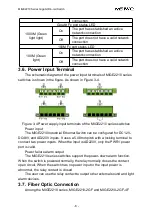
MIGE2210 Series Gigabit Din-rail Switch
- 13 -
5. Test Methods
5.1. Self-test Process
The power-on self-test phenomenon of the device under no load is:
At the moment of power-on, all the 100 Mbps Tx port indicators on the
front panel will flash once, and the two Gigabit Tx port indicators will only
illuminate yellow before the RUN indicator starts flashing, and the two yellow
lights will be off after the RUN indicator flashes. Gigabit Fx ports and 100M Fx
indicators will only be lit when an effective network connection is established,
and will normally go out.
5.2. Gigabit Tx Port Test
As shown in Figure 5-1, the switch powers up and connects two
MIGE2210-2GT devices into a chain network. Each device is connected to a
Gigabit electrical port through a direct connection cable and connected to the
test computer. Ping packets, both sides can correctly ping to the other party
without losing packets. At this time, if the computer network card is 100M, the
network port speed light (yellow light) connected to the computer should be off;
if the computer network card is gigabit, then the switch is connected to the
computer with the network port speed light (yellow light) ) should be in the
steady state, so the green light (link/ack light) on the port should be flashing. If
you see the above phenomenon, the two Gigabit electrical ports tested are
working properly.
Figure 5-1 Gigabit Tx port test connection diagram
5.3. 100M Tx Port Test
As shown in Figure 5-2, the switch is powered on, and any two 100 Mbps
Tx ports are connected to the network ports of the two test computers through
the direct connection network cable. The ping command is sent to each other.
The yellow light on the corresponding port should be always on (the computer
network card works in the 100M state) or the normal off (the computer network





































